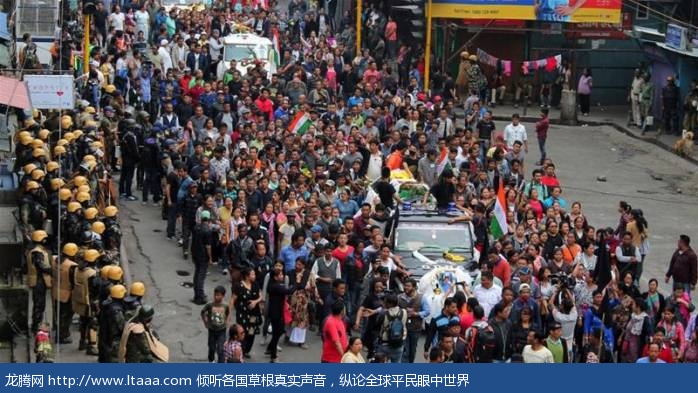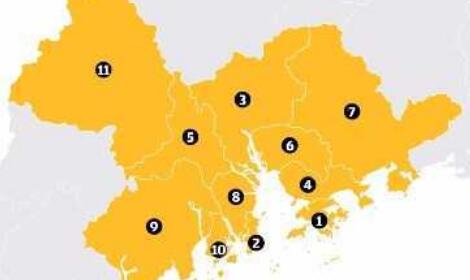[半岛电视台] 印度东北部的殖民问题 [卡塔尔媒体]
自殖民时代以来,暴力冲突一直困扰着印度东北部。卡塔尔网友:普通的拙劣噱头。有很多国家继续用着殖民主义作为他们无法建设性地发展社会的借口,并作为他们国家开始时的一个参考点。这就是个笑话。几乎所有这些国家都有跨越数千年的历史,但它们继续使用欧洲人作为他们自己失败的背景原因。非常无聊的废话。
Colonial trouble in India's Northeast
印度东北部的殖民问题
OPINION > HUMAN RIGHTS 23 JULY 2017(2017-7-23)
Violence has plagued India's Northeast since colonial times.
自殖民时代以来,暴力冲突一直困扰着印度东北部。
Supporters of the Gorkha Janmukti Morcha (GJM) rally as they carry bodies of protesters who were killed in clashes with security forces in Darjeeling, India [Reuters]
Gorkha Janmukti Morcha(GJM)的支持者抬着在印度大吉岭(在锡金南边)与安全部队的冲突中丧生的抗议者的尸体集会。[路透社供图]
作者 by Mona Chettri @mona_chettri
Mona Chettri is a Post-Doctoral Research Fellow at Aarhus University, Denmark.
Mona Chettri是丹麦奥尔胡斯大学的博士后研究员。
作者 by Arijit Sen @senarijit
Arijit Sen is a human rights researcher.
Arijit Sen是一位人类权利研究员。
"Pahar Haschey" (The hills are smiling) is the slogan used by West Bengal Chief Minister Mamata Banerjee to describe the peace and prosperity of Darjeeling under her regime. That is a difficult smile to manage given the region's history of colonisation and poverty, and the current agitation that has been going on for a month.
“山在微笑”是西孟加拉邦首席部长Mamata Banerjee用来描述在她的治理下大吉岭和平繁荣的口号。鉴于该地区的殖民历史和贫困,以及目前已经持续了一个月的骚乱,这是一个管治起来很难的微笑。
Violence and repressive governance have been an integral part of the history of the Darjeeling hills in the Eastern Himalayas. Beginning with British colonisation in the early 19th century, this colonial legacy has been continued faithfully by the extractive, neo-colonial political and financial institutions of successive West Bengal governments. Poverty, inequality between Darjeeling and other parts of West Bengal, and repression are some of the forms of violence experienced by the people of the Darjeeling hills every day.
暴力和压制性的统治一直是喜马拉雅山脉东部大吉岭山区的历史的固有部分。始于19世纪早期英国殖民统治的这一殖民遗产一直被接替的西孟加拉邦政府用精心提炼的新殖民主义政治和金融机构忠实地延续着。大吉岭和西孟加拉邦其他地区之间的贫穷,不平等,以及压迫,是大吉岭山区的人们每天经历的暴行的几种形式。
However, a generation of young hill people has grown up in the shadow of a more sinister form of violence that is perpetuated, controlled and used by the state as well as different groups: the homeland movement.
然而,山区的年轻一代在一种更为险恶的暴力形式的阴影下成长起来,这种形式被邦以及不同的团体所把持和使用,也就是本土运动。
The movement for a separate homeland for the Gorkhas of India is being spearheaded by the Gorkha Janmukti Morcha party (GJM). Since June 8, 2017, the Darjeeling hills have been engulfed in a series of violence and counterviolence - indiscriminate killing of unarmed civilians by the state police, arson by members of different political parties - all of which are obviously denied by the respective groups. As accusations and denials continue, so does the violence. There have been a number of civilian deaths while many more are still smarting from the lacerations caused by the "lathis" (batons) of the West Bengal police. In retaliation, police stations and public property have been set ablaze by homeland supporters.
为印度廓尔喀人争取独立家园的运动正在由Gorkha Janmukti Morcha (GJM)政党领导。自2017年6月8日起,大吉岭山区就被卷入了一系列暴力和反暴力事件——邦警察不加区别地杀害手无寸铁的平民,不同政党的成员纵火焚烧——明显地,所有这些都被各自的组织所否认。随着指控和否认的继续,暴力事件也在继续。有许多平民死亡,而更多的人仍在为西孟加拉邦警察的警棍所造成的伤害而承受痛苦。在报复行动中,警察局和公共财产被本土运动的支持者点燃烧掉。
These latest skirmishes gave rise to a sense of deja vu. Entrenched in the collective memory of Darjeeling hills is the trauma of the homeland agitation of 1986, which brought violence on a scale and intensity that had never been experienced previously. Those who experienced this agitation first-hand still recall painful memories of being terrorised by the police, countless family tragedies, disappearances, extrajudicial killings, arson, inter-party violence and counterviolence.
这些最新的小冲突引起了一种似曾相识的感觉。在大吉岭山区的集体记忆中根深蒂固的是1986年的家乡骚乱的创伤,它带来了前所未有的规模和强度的暴乱冲突。那些亲身经历过这种骚乱的人仍然记得那些被警察恐吓,无数家庭悲剧,失踪,法外处决,纵火、聚众暴力和反暴力的痛苦回忆。
This agitation concluded in 1988 with the formation of the Darjeeling Gorkha Hill Council (DCHC). The demand for a separate homeland remained latent, only to resurface in 2007 and in 2011 with the formation of Gorkha Territorial Administration (GTA). But this second administrative set-up also failed to bring lasting peace and prosperity to the region. While both DCHC and GTA were supposed representations of a regional devolution of power, in reality, they were mere tokens of appeasement as every aspect of hill administration was still controlled by Kolkata.
这一骚乱终结于1988年大吉岭廓尔喀山区议会(DCHC)的成立。此后对独立家园的要求潜伏着,只是在2007年和2011年,随着廓尔喀区域行政机构(GTA)的成立而重新浮出水面。但这第二次行政安排也未能给该地区带来持久的和平与繁荣。虽然DCHC和GTA都被认为是区域权力下放的代表,但实际上,他们仅仅是安抚政策的象征,因为山区政府的各个方面仍然受到加尔各答(西孟加拉邦首府)的控制。
Repression and dissent
More than three decades after the two-year long, violent Gorkhaland struggle that began in 1986, in June this year, the state government proposed a law that would make the Bengali language compulsory in the predominantly Nepali-speaking hills. Though withdrawn, this policy of cultural imperialism has been enough of a catalyst to galvanise the local population for another homeland movement.
镇压和异议
从1986年开始的长达两年的廓尔喀兰暴力斗争已经过去了30多年,今年6月,邦政府提出了一项法律,强制以尼泊尔语为主的山区使用孟加拉语。尽管撤回了,这种文化帝国主义的政策作为催化剂已经足以激起当地人民进行另一场本土运动。
Although there are layers of local and regional political machinations behind the last wave of protests, the state's attempt to repress dissent with violence played a crucial role in the latest escalation.
尽管在最后一波抗议浪潮背后,有一些地方和地区的政治阴谋,但邦试图用暴力压制不同意见,这在最近的冲突升级中发挥了关键作用。
Paranoid about losing territory and resources, the West Bengal government refuses to acknowledge the demand for Gorkhaland as a political issue. It has always viewed homeland movements as law and order problems, which can best be resolved by beating the hill people into submission. This neocolonial attitude, while evident in different policies pertaining to the hills, has been most prominent during the agitations of 1986 and 2007, as it is again in 2017.
偏执于对失去领土和资源的疑虑,西孟加拉邦政府拒绝承认廓尔喀兰诉求是一个政治问题。它总是把本土运动看作是法律和秩序的问题,可以通过把山区人民打击到屈服的方式最好地解决。这种新殖民主义的态度,虽然在涉及山区的不同政策中表现得很明显,但在1986年和2007年的骚乱中最为突出,2017年又再次出现。
'Taming the native'
On June 15, 2017, a police raid on the house of the GJM leader Bimal Gurung led to the discovery of a cache of items that, according to state authorities, "no peace-minded person would store". The confiscated items included a "khukuri", a machete shaped knife used as a domestic implement by the Gorkha, agricultural tools, as well as bows and arrows - items which are common in Himalayan households.
“驯服本地人”
2017年6月15日,警方对GJM领袖Bimal Gurung的房子进行了突击搜查,发现了一些物品,根据邦当局的说法,“没有一个爱好和平的人会保藏的”。被没收的物品是喜马拉雅家庭中常见的,包括一种廓尔喀人用作家庭工具的弯刀,农业工具,以及弓箭。
The underlying assumption that justifies labelling these common and culturally significant items as dangerous is the age-old colonial discourse that classifies hill people as inherently irrational, sentimental, and prone to violence. Owing to popular public narratives around bravery, loyalty and sacrifice for India, there is an expectation from the hill community that their contributions will be politically acknowledged through the formation of a separate state. Instead, their agricultural tools, which are apparently a confirmation of violence latent within hill people, are confiscated.
把——给平常且有厚重文化内涵的物品贴上危险标签——这种行为合法化正义化的潜在性理由,是一种古老的殖民论调,这种论调认为山区人民天生不理性、感情用事、容易发生暴力。对印度一方的勇敢、忠诚和牺牲的公开描述广泛流传着,山区人民期望,他们的贡献能够通过建立独立政权在政治上得到承认。相反,他们的农业工具,明显地被认定是山区人民潜藏的暴力,被没收了。
Unfortunately, these recent instances of violence involving local citizens and political leaders have proven that colonial narratives will continue to dictate how the Darjeeling hills and its people are romanticised, governed or repressed. When the stereotypical, docile hill person protests against years of subjugation, status quo must be established through violence.
不幸的是,最近发生的涉及当地居民和政治领导人的暴力事件已经证明,殖民主义的故事将继续述说着大吉岭和它的人民是如何被浪漫化、统治或压制的。当守旧的、温顺的山区人民还在抗议着多年的镇压的时候,必须通过暴力来建立想要的现状。
In India, state violence has become the language of politics for silencing the poor, the lower castes, minorities, and the disenfranchised. In different spaces of such confrontation around the country, state brutality that includes excessive use of force and torture remains constant.
在印度,国家暴力已经成为压制穷人、低种姓、少数民族和公民权利被剥夺者的声音的政治语言。在全国各地不同空间里的这种对抗中,包括过度使用武力和酷刑在内的国家暴行仍然在持续。
Cycles of state-led violence, ceasefires and counterviolence have established a framework of violence which has penetrated local political institutions and communities and transformed Darjeeling into an exceptional zone.
由国家主导的暴力、停火和反暴力的周期环路,已经建立起一个渗透到各地政治机构和社区的暴力框架,使大吉岭变成了一个特别异常的区域。
The tactics of repression that was at its height during the Gorkhaland movement in the 1980s - intimidation, disappearances, threats and harassment - are now visible in their diluted version in local politics in Darjeeling and are once again shaping the political terrain of the region. The hills may not have descended into complete chaos yet, but the fear of violence is affecting everyday decision-making and making it impossible for conflicting parties to reach an agreement for lasting peace.
在20世纪80年代的廓尔喀兰运动中,镇压的策略——恐吓、失踪、威胁和骚扰——在现在的大吉岭地方政治中还可看到有所收敛的版本,再次塑造着该地区的政治面貌。这些山区可能还没有完全陷入混乱,但对暴力的恐惧影响着日常决策,使冲突各方无法达成持久和平的协议。
Regarding the current violence, GJM leader Gurung has said that all the protests so far are a trailer. The real violence is yet to begin. The anxiety continues as the Kolkata High Court has asked for extra security forces to be sent to the hills and the Supreme Court of India have appealed to all citizens for peace.
关于目前的暴力事件,GJM领袖Gurung说到目前为止所有的抗议活动都是预告片。真正的暴力还没有开始。随着加尔各答高等法院要求将额外的安全部队派往山区,印度最高法院呼吁所有公民寻求和平,这种担忧仍在继续。
In a multiethnic space like Darjeeling, where every call for an ethnic homeland stokes fires of interethnic conflict between the Nepali/Gorkha and the Bengali communities, it is important to acknowledge the culture of violence that has become a part of political institutions. To achieve sustainable peace, state actors and local community representatives should have a dialogue bereft of mutual suspicion and they should work towards stemming the culture of violence locally.
在像大吉岭这样的多民族地区,每一次对本土家园的呼吁都引发了廓尔喀(尼泊尔民族)和孟加拉社会之间的种族冲突,认识到暴力文化已经成为了政治制度的一部分,是很重要的。为了实现可持续的和平,国家行动者和地方社区代表应进行对话,以消除相互猜疑,并且应当努力制止当地的暴力文化。
In the 1980s, after the Gorkhaland Agreement was signed, the West Bengal state broadcaster started beaming a half-an-hour cultural show called "Nepali Programme" on television every evening at 5:30pm. For Darjeeling to breathe easy, in 2017 the state has to think beyond the tokenism of a 30-minute cultural inclusion on state TV and a smile from the chief minister's imagination.
20世纪80年代,在廓尔喀兰协议签署后,西孟加拉邦电视台每天下午5点半在电视上播出半小时的文化节目——“尼泊尔节目”。2017年,为了让大吉岭松口气,该邦必须跳出——在官方电视台播30分钟文化节目,以及首席部长所幻想出来的微笑(指‘山在微笑’口号)——这种表面功夫的观念。
13 days ago (13天前)【天数从2017-8-8倒推】
Kyphe Deum
The History of Darjeeling begins in 1765 and the history of violence begins with the The Gorkha invasion and subjugation of the native Lepcha and Kirati people in 1790. But ofc you ignore anything that does not fit your racist narrative.
大吉岭的历史始于1765年,暴力历史始于1790年廓尔喀人对当地Lepcha和Kirati人的入侵和征服。但是你忽略了任何不符合你种族主义叙述的东西。
14 days ago
Makombo
"history of colonisation and poverty, and the current agitation"
As long as the sub continental species insists on lingering at the bottom of the evolution tree, nobody and nothing can be blamed.
S@vages take time to evolve - a couple of centuries at the least - smart westerners came to that realisation, left and quit investing money and resources in an incorrigible zoo
“殖民化和贫穷的历史,以及当前的动乱”
只要次大陆物种坚持在进化树的底部徘徊,就不能指责任何人与任何事。
野蛮人需要时间来进化——聪明的西方人用了至少几个世纪才意识到这一点,然后离开,并放弃向一个不可救药的动物园里投资金钱和资源
14 days ago
Propa Ganda
Independence for all minorities.
所有少数民族,独立。
13 days ago
Asif62Mayet
India must be broken in to 1000 entities.
印度必须分裂成1000部分。
14 days ago
Niren Pradhan
So sad...
如此令人伤心…
16 days ago
Thupten Chodak
What to expect from Aljazeera..always Anti India...now onder you are getting kicked out from left and right???
可以从半岛电视台期待什么?总是反印度…现在,到你被人从左到右踢走了? ? ?
14 days ago
Ugly_Dothead
Why are hindus so ugly?
为什么印度人这么丑陋?
14 days ago
uglyhindu_cow
Because we eat cow dung and worship cows that's why we are ugly
因为我们吃牛粪,崇拜牛,所以我们才丑陋
14 days ago
uglyhindu_cow
Poor Hindu dogs love revelling in other people's stories but don't like it when truth is told about us ugly Hindus. How sad
可怜的印度狗狗喜欢陶醉在别人的故事里,但当别人告诉我们印度人丑陋的真相时就不喜欢。多么悲伤
14 days ago
Peter Gray
Amjad Hussein, you're no more a Hindu than an Eskimo is. Knock it off you little freak.
Amjad Hussein,你比爱斯基摩人更像印度人。别闹了,你这个小怪物。
16 days ago
Akh ILY
A disturbing video of an Indian Muslim man being brutally lynched by 11 people armed with swords and sticks in Maharashtra state has gone viral on social media and prompted a debate on the victim’s identity.
According to reports in Indian media, the victim, whom police identified as a Muslim Rafiquddin, , was having tea at a roadside stall in Dhule, around 280 km from Mumbai, when he was attacked.
Gruesome CCTV footage shows a group of about 11 men pulling Rafiquddin onto the street in public view and striking him with swords and sticks. They continue to hit him even as he lies unconscious and accumulated rainwater around him turns red with blood.
Welcome to India
一段令人不安的视频显示,在马哈拉施特拉邦,一名印度穆斯林男子被11个手持刀和棍棒的人残忍地处以私刑,这一视频在社交媒体上病毒式扩散,引发了一场关于受害者身份的争论。
据印度媒体报道,被警方确认为穆斯林Rafiquddin的受害者遭到袭击时,正在距孟买280公里处的Dhule路边摊喝茶。
令人毛骨悚然的闭路电视画面显示,一群人,大约11个,众目睽睽下把Rafiquddin拉到大街上,用刀和棍子打他。即使他昏过去了,他身下积聚的雨水也被血染成了红色,他们还是不停地打他。
欢迎来到印度
16 days ago
Alan Foster
Thank you, Ajazz for providing this article on an ongong issue that most people have never heard of. Very informative regardless of what one may think of the authors' political positions.
It's easy to see how Darjeeling's natural beauty could mask underlying cultural and sociopolitical conflicts. I'll never forget the sight of diminutive Nepali laborers hauling huge sacks of bricks, cement, and other building materials on their backs up the city's steep streets, at altitude. Not in the tourist brochures.
半岛电视台,谢谢你提供了这篇大多数人没听过的ongong问题的文章。不管你怎么看作者的政治立场,这都是非常有用的。
很容易看出大吉岭美丽的自然如何掩盖了潜在的文化和社会政治冲突。我永远都不会忘记亲眼所见的那些身材矮小的尼泊尔劳工用他们的背把大量的砖头、水泥和其他建筑材料拖上高海拔的陡峭街道的景象。不是在旅游手册里。
16 days ago
Climp Jones
the usual boorish claptrap. So many nations continue to use Colonialism as an excuse for their inability to constructively develope their societies and as a point reference as to when their nations began. Its a joke. Just about all of these nations have histories spanning thousands of years and yet they continue to use the Europeans as a back drop for their own failings. Very tiresome nonsense
普通的拙劣噱头。有很多国家继续用着殖民主义作为他们无法建设性地发展社会的借口,并作为他们国家开始时的一个参考点。这就是个笑话。几乎所有这些国家都有跨越数千年的历史,但它们继续使用欧洲人作为他们自己失败的背景原因。非常无聊的废话
14 days ago
shana beg
Climp , Europe doesn't let anyone move forward .. by causing trouble or stealing from dark skinned lands
Climp,欧洲通过制造麻烦或从黑土地巧取豪夺来阻止任何人前进。
14 days ago
uglyhindu_cow
We Hindus by everyone but ourselves
If a chicken goes missing in India the Pakistanis stole it or if we Hindus sh it on the streets then the Chinese are to blame
You understand?
除了我们自己,我们都是印度人
如果一只鸡在印度失踪,是巴基斯坦人偷了它。或者,如果我们印度人在街上大便,那么应该谴责中国人。
你明白吗?
16 days ago
Anonymous
NOT BAD, AL JIZM ! Atleast now you're attacking the right people. F uck Mamata Bannerjee.
不错,AL JIZM!至少你现在没搞错对象。Fvck Mamata Bannerjee(西孟加拉邦首席部长)。
14 days ago
uglyhindu_cow
Stop drinking cow urine
停止喝牛尿
16 days ago
Neetu Chamling
Thankful for writer for presenting unbiased and fact based article on Darjeeling India. Our own country 's Media could not present holistic and truthful situation & conditions. State Government is trying to suppress, Gorkha's movement in Hill by trying all possible ways e.g total internet ban, open firing on arm less protesters, controlling media movements, banning news channels, stopping supply of food and medical items to Hill etc. This is very sad to say, that our own local media of India is mum on Human rights violation issues in Darjeeling. Journalism is most powerful weapon in modern world, wish our Indian media has also shown some respect to true journalism.
感谢作者发表了关于印度大吉岭的不偏不倚的基于事实的文章。我们自己国家的媒体无法呈现全面和真实的情况和条件。邦政府正试图通过各种可能的方式镇压廓尔喀山区的运动,比如全部断网,向无武器的抗议者开火,控制媒体活动,禁止新闻频道,停止供应食物和医疗用品等。说起来让人很难过,我们自己的印度当地媒体对大吉岭的人类权利侵犯问题保持沉默。新闻是现代世界最有力的武器,希望我们的印度媒体也能尊重一下真正的新闻。
15 days ago
MOHAN
Thug Republik has media control, most of its media is run by Cronies and Bramins - the thievery INC.
恶棍共和国控制了媒体,它的大部分媒体都是由亲信和婆罗门——盗窃集团运营的。
16 days ago
Samir Thapa
The most truthful research on Gorkhaland movement, its causes and repercussions. When khukhri, bows arrows, sickle, spades are termed are called cache of arms to justify the murdering of Gorkha youths, what else can be said. Gorkhas are called terrorists for taking candle light protests. The basic food and medication to Hills, Terai are blocked by Bengal government. So conclusion is that if we had Gorkhaland all this suppression and persecution would not be there.
关于廓尔喀兰运动的原因和影响的最真实的研究。当khukhri,弓箭,镰刀,黑桃被当作隐藏的武器,以证明谋杀廓尔喀青年是正当的时候,还有什么可说的。因为参加了烛光抗议活动,廓尔喀人被当作恐怖分子。送到Hills和Terai的基本食物和药物,被西孟加拉政府阻断了。所以结论是,如果我们有了廓尔喀兰,所有这些镇压和迫害都不会再有了。
13 days ago
Thein Maung
Do Gurkhas have to part of India you are very basically different from the prevailing ARAYANS.
廓尔喀不得不成为印度的一部分吗,你们基本上和占优的Arayans人很不同。
16 days ago
uglyhindu_cow
We Hindus are rap ists and child mol esters and ugly smelly unhygienic dogs that is why no one wants to live with us :(
我们印度人是弓虽女干犯,儿童猥亵者,又丑又臭又不卫生的狗狗,这就是为什么没有人想和我们住在一起的原因 :(
16 days ago
Ahmed Ak
Too right
说得对
版权声明
我们致力于传递世界各地老百姓最真实、最直接、最详尽的对中国的看法
【版权与免责声明】如发现内容存在版权问题,烦请提供相关信息发邮件,
我们将及时沟通与处理。本站内容除非来源注明五毛网,否则均为网友转载,涉及言论、版权与本站无关。
本文仅代表作者观点,不代表本站立场。
本文来自网络,如有侵权及时联系本网站。
图文文章RECOMMEND
热门文章HOT NEWS
-
1
他们认为,协商失败的峰会实际上符合中国的利益,而且北京的影响力将增加,因...
- 2
- 3
- 4
- 5
- 6
- 7
- 8
- 9
- 10
推荐文章HOT NEWS
-
1
这是中国中部河南省郑州的一个普通的星期六。富士康工厂大楼上空笼罩着...
- 2
- 3
- 4
- 5
- 6
- 7
- 8
- 9
- 10











